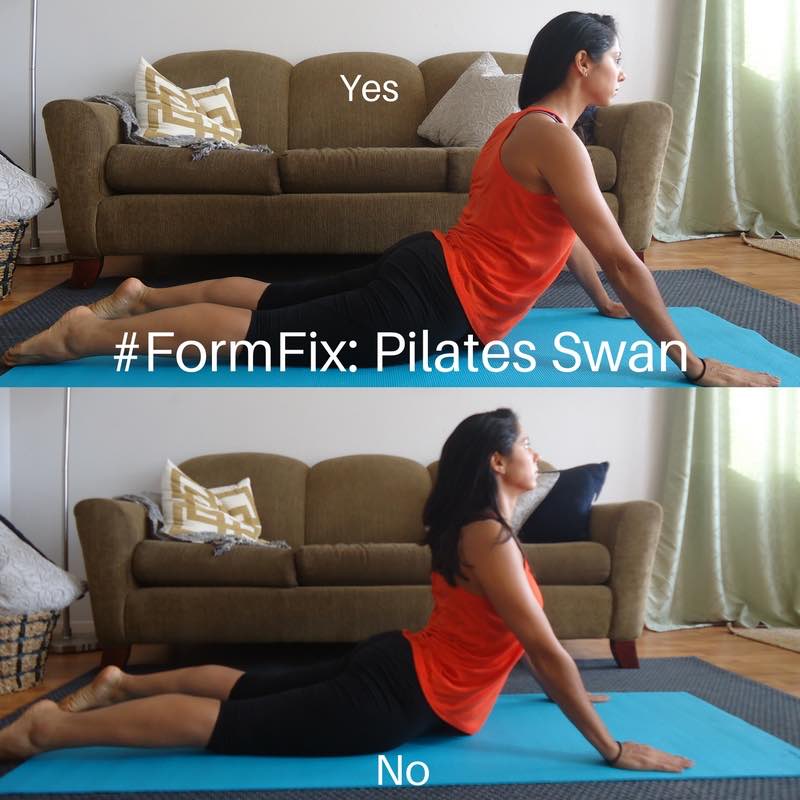The number one question I get from someone unfamiliar with Pilates is “Is it like, a lot of abs?”
Who knows where this notion comes from, but real Pilates is so much more than a single muscle group. A typical workout will have one’s spine moving in multiple planes of motion, including extension. The Pilates swan is one of those energizing extension exercises (how about that for alliteration?) that unfortunately, leads to more pain and little gain when performed incorrectly. This is mainly due to a misunderstanding around what spinal extension actually is. So first things first.
The basics of a healthy spine
Joseph Pilates insisted that a healthy spine is a mobile spine. It should move with ease, like a wheel, and with fluidity. The man was on to something because even in his 60’s, he moved like a 13-year-old gymnast thanks to a very mobile spine.
If our spine is stiff or achy, how can we possibly move freely and enjoy life? Back pain is not the norm, my friends, so anyone that blames that feeling on old age has surrendered to a life of discomfort when they could simply get stronger and make their spines more mobile. A healthy spine is not only crucial to everyday activities, but it should easily move in forward flexion, extension, lateral flexion (side bending), and rotation. All of these planes of movement are essential to healthy living and a healthy spine, but extension is increasingly more important in an age where most of us are locked in thoracic flexion.
The Swan is a basic extension exercise in Pilates that allows one to elongate the thoracic spine through the crown of the head. At least, that’s what it should feel like. Unfortunately, the combination of poor posture, faulty movement patterns, terrible instruction and even yoga (or maybe it’s yoga done wrong), many of us think of the Swan as a mini-back bend or Cobra pose. Now, I’m not a yoga instructor or am knocking on yoga, but as an instructor I’ve found that most of my students and clients who butcher this exercise do so because they’re mimicking what they think a yoga Cobra pose is.
Newsflash people: Pilates is not yoga.
Yoga is not Pilates.
These are two separate modalities with separate origins, histories, flows, exercises and purposes. You wouldn’t tell a bodybuilder that the sport of bodybuilding is like powerlifting, now would you? Of course, not! They may be lifting weights but it’s two different sports with different strength training philosophies and purposes. But I digress…
How to do the Pilates Swan
In the incorrect version of the swan (bottom picture), notice how my lower back is pinched. My shirt is really crinkled in that area and upon closer inspection, my low back is in this tight little c-curve rather then in a diagonal line from the low back to the top of the head. Seriously, take a close look to notice the differences in these photos because they are so subtle. In this incorrect position, I’ll feel everything in the low part of my back which is a clear indication that one is doing it wrong.
The swan is actually a movement from the mid back to the crown of the head, meaning that as one lifts from the ground (the start position), they are growing or lengthening their spine up and away at a diagonal rather than reaching the head up towards the ceiling as high as it can go.
Here are some simple cues I use with my clients to teach them how to rise up into swan properly:
– Start with your eyes down on the mat, hands and forearms touching the floor.
– Lift your gaze up first (NOTE: Your gaze = your eyes, not your head or neck)
– Start to float your throat away from the ground.
– Now float your collarbone away from the ground. Then your sternum.
– As you keep lifting into swan, imagine the top of your head is growing towards a wall in front of you. Continue to push off your arms and lifting one vertebra away from the floor one at a time.
– The rib cage should remain closed, not flaring out.
A full swan can take time to learn and execute properly. Don’t be discouraged by this! As your spine becomes more mobile and healthier, you can increase its range of motion into full (adult) swan.
Did you find this article helpful? Share it with a friend or connect with me about it in the comments below.


Comments 2
My favorite spine saver! I keep forgetting to do this! I’ll make it my breakfast
Author
LOL. Pilates swan with a side of eggs. Yes, I love this one to gently wake up the spine. The rollup too is a great one!